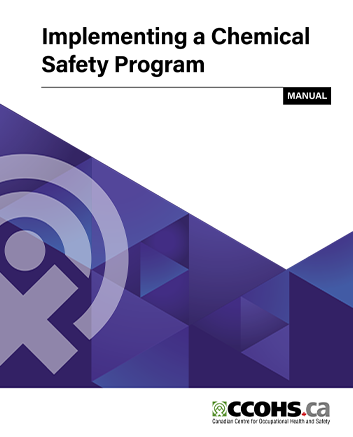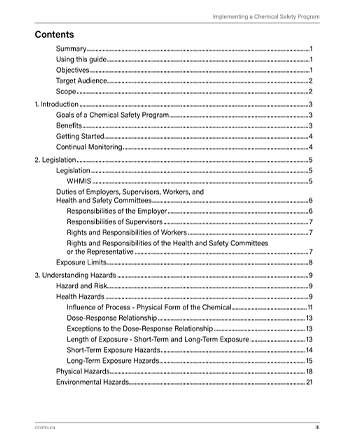Scheduled maintenance - Thursday, July 12 at 5:00 PM EDT
We expect this update to take about an hour. Access to this website will be unavailable during this time.
Use the information, samples, and checklists in this manual to develop or improve your chemical safety program.


Chemicals are present in every workplace ranging from cleaning products to chemicals produced on site.
Having a chemical safety program in your workplace will reduce health and safety risks, lower environmental impact, and reduce operation costs. If chemicals are not used, stored, and handled properly, they can cause injury, illness, disease, fire, explosions, or property damage.
A chemical safety program does not have to be complicated or costly. The overall goal is to establish a program that considers the entire lifecycle of the chemical or process - beginning with purchasing and including identification, labelling, inventory, use, storage, record-keeping requirements, and disposal.
This manual will help you by providing step-by-step guidance on understanding, controlling, and safely working with chemicals.
This 138-page manual provides good practice information about the safe use and control of chemicals in a workplace.
It will help you to:
It will also help organizations:
This manual provides the information, samples, and checklists needed to start or improve your chemical safety program. It will also help you understand how to work safely with chemicals, their health hazards, and storage, handling, and other aspects of chemical safety. The actual chemicals that are present and their hazards, as well as the size and complexity of your specific workplace, will determine the level of program that you need.
Businesses small and large can use this manual. You can customize the information in this publication to best match the chemical hazards in your workplace.
NOTE: The information in this publication is based on “good practice” principles and techniques. The purpose of this manual is to provide guidance, rather than prescribe specific requirements, and is not intended as a legal interpretation of any federal, provincial or territorial legislation.
Topics include:
This manual is recommended for anyone who is committed to providing a workplace that is healthy and safe from the hazards associated with chemicals.
It will assist employers, owners, managers, supervisors, operators, health and safety committees, chemical management teams, workers - and the organization as a whole - by providing guidance about the development, maintenance, and continual improvement of a chemical safety program.
Each publication produced by CCOHS undergoes several stages of review. As part of this review, representatives from government, employers, and labour are requested to comment on draft copies of CCOHS documents for technical accuracy and readability.
Although every effort is made to ensure accuracy and completeness of the information, it is understood that CCOHS makes no warranty as to the accuracy or completeness of such information and assumes no liability for any damages or loss suffered as a result of any inaccuracy or incompleteness therein.
CCOHS publications are unique in that they are developed by subject specialists in the field, and reviewed by representatives from labour, employers and government to ensure the content and approach are unbiased and credible.
Although our publications are protected by copyright, permission for non-commercial reproduction may be provided.
Please use our Copyright Authorization Form to request permission, or contact us for more information.